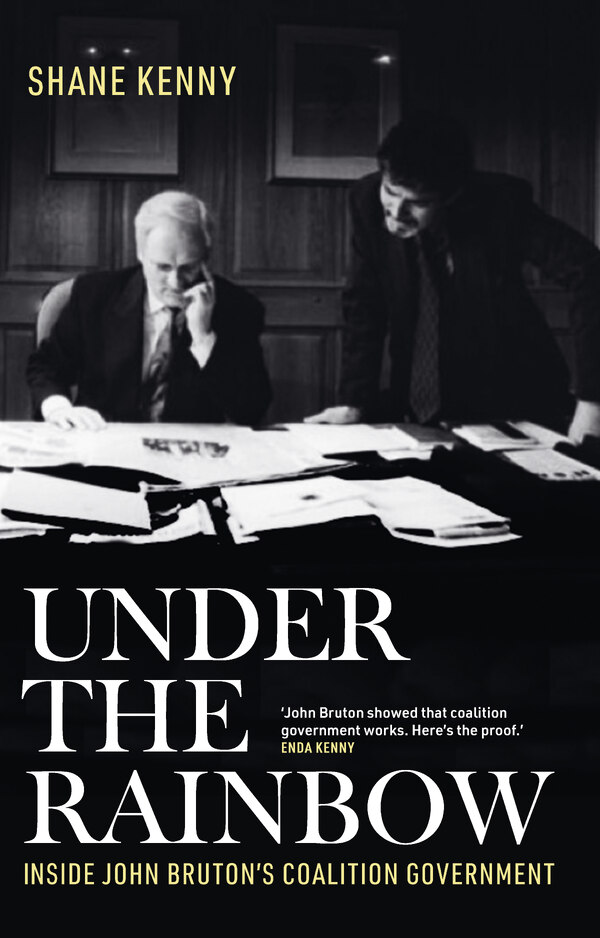SHANE KENNY
Gill Books
€24.99
ISBN 9781804581865
REVIEWED BY
Barry Walsh
Barry Walsh is a solicitor and a former policy adviser at the Department of An Taoiseach.
Political diaries and memoirs are an important source for historians, since they can often give a sense of the atmosphere that surrounded key events, years before official records are released. In Ireland we have less of a tradition of political memoirs and diaries than our neighbours in the UK. However, the two stand-out examples are the memoirs of the late Gemma Hussey, which graphically illustrated the personal strain and sense of powerlessness often felt by senior politicians, and those of Fergus Finlay, which illustrate the darker machinations of politics behind the scenes.
Shane Kenny, who was government press secretary from 1994 to 1997, has made a fine addition to this canon. But it’s important to be clear about what this book is and what it is not. Professor Gary Murphy is quoted on the reverse cover as saying that the book is ‘an enthralling memoir of the Rainbow coalition’, while former taoiseach Enda Kenny is quoted as saying that it shows that ‘coalition government works’. With the greatest of respect to both gentlemen, I’m not sure that they read the same book as I did. Shane Kenny has written a fine account of the impact that Bruton had during vital stages of the Northern Ireland talks but, disappointingly, it is certainly not a behind-the-scenes account of the Rainbow government in the mould of Hussey and Finlay.
There is no real examination of the inner workings of the coalition, or what made it so cohesive. Bruton’s surprisingly close relationship with Dick Spring and Proinsias De Rossa was its key driving force, and yet both men are mentioned just five times between them outside of the context of the Northern Ireland talks. Kenny gives no insight whatsoever into the relationship between this triumvirate.
The divorce referendum—arguably the Rainbow’s greatest domestic policy victory—is dealt with in just three pages. The BSE crisis is discussed at length from a British perspective but, bizarrely, no mention is made of how it was dealt with in Ireland. Kenny refers to the Rainbow’s greatest strategic blunder—calling an early election in June 1997—as a ‘tragic mistake’, but gives scant detail on the events that led to the decision.
Meanwhile, fourteen of the book’s 21 chapters—almost 300 of its 373 pages—focus on Northern Ireland, or EU or international affairs. So this begs a question: why did Kenny and Gill Books market what is a fine account of a key period in the Northern Ireland talks as a book about the Rainbow government? The likely answer is the reality that, while political memoirs have a limited audience, books focusing on Northern Ireland have an even narrower appeal, so this decision was surely a commercial one. Nevertheless, this is a book that deserves to be recognised for its strengths.
The five-year period between 1992 and 1997, and the key contributions of John Bruton, John Major and Albert Reynolds to the Northern settlement, are in dire need of re-examination. An avalanche of state papers from these years has been released in recent times and it will surely take historians decades to sift through them, but Shane Kenny makes a valiant first attempt here to reevaluate the impact of Bruton in particular.
Kenny carefully traces the contents of the Framework Documents, which have been virtually airbrushed from history, showing that they were the foundation stones of the three strands of the Good Friday Agreement. He details the ‘tortuous political struggle’ between February and December 1995 in which Bruton slowly dragged Major away from his insistence on IRA decommissioning before Sinn Féin were admitted to talks. He also gives a detailed account of an extraordinary telephone altercation between the two men in the wake of the disastrous RUC mishandling of the 1996 Drumcree stand-off. Kenny’s account provides important context and counterbalance to Major’s version of these events as relayed in his own 1999 memoirs.
Kenny also shows that Bruton and Nora Owen were key to smoothing the way for George Mitchell to chair the talks, and that the crucial decision to set a deadline of the spring of 1998 was Bruton’s idea in the first place. The author makes one truly jaw-dropping claim—that John Hume had told him in 1995 that he agreed with Bruton’s long-held view that the 1916 Rising was a mistake and intended to say as much at a future date. This is a startling insight into Hume’s thoughts on the historical roots of Irish nationalism, and one which surely deserves further study.
Throughout the book, Kenny paints an excellent picture of Bruton’s personal conflict between his sense of duty to act as the leader of Irish nationalism and his loathing of the Provisional IRA and their campaign of violence. Nevertheless, having known Bruton personally in the years following his retirement from politics, I couldn’t help but feel that Kenny’s book lacks insights into his personality outside of the narrow context of the Northern talks. A full biography will be needed for that picture to be properly painted.
Writing in 1999, George Mitchell said that Bertie Ahern and Tony Blair owed their eventual success in April 1998 ‘to their predecessors who had begun the peace process and kept it going’. For all its flaws and lack of clear focus, in respect of John Bruton, at least, Kenny has made the first serious attempt to illustrate this, and has provided a valuable new perspective for future historians.

